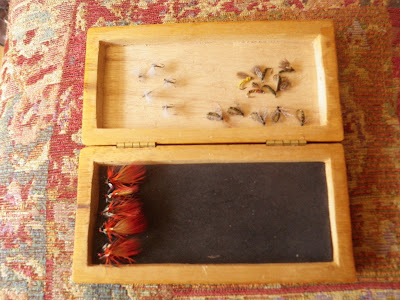 |
| Homemade rod tube and reel case |
‘Tis poverty alone, Diophantus, that awakens the arts;
poverty is the very teacher of labor…’
Theocritus, from the Fisherman’s Dream: 3rd
century BC
The other day an angler friend sent me a care package
containing, among other things, a complete leader building kit consisting of
dozens of tippet and leader spools sorted by diameter, and a leader gauge. I
have not built full trout leaders for quite some time, but upon receiving such
a generous gift, sat down to do a little experimentation. I started with taking
readings on various leaders I have from the 1970s through the modern day, and
by reading leader specifications from Bergman, Ritz, and others. After fiddling
around with a pencil and paper and a tape measure, I came up with 2 very
different formulas for a 9-foot 4x leader. I assembled them, coiled them in
envelopes labeled with the measurements and dimensions, and set a book on top
of them by error. Today I found them while moving the book they rested under.
It being sunny, I thought it no better time to try them out in the yard on
several rods. The jury is out yet on which design I like better, but the
end-game is not the subject of this diversion, it is the journey…
For many fly anglers, especially of the older generation,
thrift and necessity led to experimenting with equipment. Thrift because, well
just that: many of us had little means at the time, and a dollar saved was a
dollar more for gas money to get us to the rivers. Necessity because the
extraordinary expanse of good tackle and options available today was just not
around yet.
In talking to other anglers both contemporary and older than
me, I was told stories which led to this theme being developed. There were
consistencies in the tales of homemade fixes, invention, and experiment that
led to critical thinking and a foundation in the sport. That led directly to
innovations in product available today, but also created better anglers more
connected to their sport. Whether it was thrift or necessity or both matters
not, it led to the same learning process.
Let’s look at a few examples…
When one had a fly-line that was too bright or the wrong
color, boiling red onionskins produced a colored liquid that dyed the line a
more muted color of buckskin and olive. Onions were cheap, and you could fry
them with some sausage and peppers afterward and have a nice dinner.
When fishing with a braided or furled leader, loops for
connection were often not available. Orvis braided leaders at the time came
with a hollow butt and instructions on how to strip the end of the fly line
with acetone. One then attached the braided leader permanently to the fly line
with super glue and a careful insertion of the line tip into the hollow butt of
the leader. If you wanted to put on a sink-tip, you either needed to cut the
whole affair apart and start over, or come up with some novel solution.
Modeling clay rubbed into the braid would work great, but then it was near
impossible to extract it. The solution was ingenious: toothpaste. One rubbed
toothpaste into the braid of the leader and it sank nicely. If you wanted it to
float again, just rub out the toothpaste in the water and treat it with
silicone. It also had the side-effect of shining up the teeth of the trout.
Nothing like a little impromptu dental care to help nature along!
When faced with a challenge, anglers overcame it the only
way they were able to, by experimenting around the kitchen table and futzing
their way to a solution through creativity.
Take my first sink tip for salmon and steelhead. I went to
Reinke Brothers on Greenfield Avenue in Milwaukee, a business that has been in
the same place since its founding in 1950. I remember going there with dad on
the bus from our east-side home. It took two hours back in 1975. The place
hadn’t changed much twenty-odd years later, and I recognized various pieces of
rod-building accessories dad had used in building his fiberglass rods. I found
a thirty-foot coil of lead core line with a braided outer surface. For three
dollars, I purchased it along with sundry feathers and whatnot, and went home
and constructed interchangeable sinking tips. I saved money, and I learned to
whip braids and coat the line with pliobond. They worked great until the lead
separated and flew out of the core in little pieces that hit you in the head on
the forward cast, but I caught fish with them! It laid a foundation that
enabled me in later years to splice fly lines and add loops.
My first fly rod was a blank purchased from the same store,
and hand-assembled and wrapped at my kitchen table in my apartment. I still
have it. It is a nice 8 weight. I learned so much by building it (with dad’s
old rod making tools and components), that I built a second one. I think the
whole kit and caboodle set me back 40 bucks.
Since I had no money at the time, my first fly-box was one I
made from a piece of mahogany carved while sitting on the couch with no tools
but a pocket-knife that was given me by my mom and purchased at my
Grandfather’s hardware store, Theisen Brothers, in central Wisconsin sometime
in the 1940s. The box worked fine, and I learned how to carve wood and why
doing it on your couch might lead to an adventure with a vacuum cleaner.
 |
| wood fly box carved with pocketknife |
We bent the available hooks we had with pliers in order to
make them fit the intended fly patterns. We sewed fleece patches to the back of
old ball caps to hold flies.
Last year I acquired my first silk fly lines. I am of the
plastic generation, but curiosity and historical knowledge drove me to goof
around with them. The initial process of mixing boiled linseed oil with
turpentine and spar varnish and treating the lines while monitoring the
relative stiffness, flexibility, and smoothness of the stages of transformation
gave me a deeper appreciation of what it took at one time to just go fishing.
The sheer amount of necessary preparations both before and after a day on the
stream might put many of today’s anglers off their beer. It sure taught
patience, and a reverence of and care of one’s tackle. Cane rods were rubbed
down and dried before they went back into their tubes, and the silk lines had
to be dried every night by removing them from the reel, and then treating them
with mucilin in the morning. These little tackle rituals performed of necessity
every day one went fishing were just part of the whole experience.
I am self-taught through experimentation, failure, success,
and reading. I guess that was the way I was raised. Our home was always filled
with books. Dad was an avid reader, as was mom. Dad was a classical pianist who
was mostly self-taught, and even tuned his own grand piano, although in the
invective-filled afternoons and evenings he sat on the floor with the whole
keyboard action disassembled and by now getting a bit into the brandy, we
wished he would just pay for a professional tuner. We were all autodidacts from
a sense of curiosity, thrift, and necessity. I cherish that upbringing now here
in 2018 when I needed a sign for my business guiding and teaching fly-fishing.
Instead of just getting a sign painter to make one for me, I did it myself, and
learned that this kind of reward from creativity can be exhilarating. It turned
out quite nice.
When my mother began her painting in Wisconsin in the 1940s,
she attended Layton School of Art in Milwaukee. Her teachers were among the
noted Wisconsin artists of the 20th century, as she became as well.
They focused on foundation first. The students were taught to mix their own
mediums, create resins and rabbit glues, and blend all sorts of toxic mixtures
to allow them to paint with oils on a board in the styles of the old masters.
Mom had a basement full of what looked like apothecary bottles with faded hand
lettered labels, but they would allow her to prepare any surface for any medium
of painting at will, and not be dependant on the availability of store-bought
materials. Of course, thrift also played a part here for both my parents and
many of the anglers who we owe so much to were children of the great
depression, where money was tight or non-existent, and everything had to be
made from scratch or modified… thus homespun.
In that foundation that was laid by experimentation, reading
and soaking up knowledge, and trial and error, expertise was born, in angling,
art, and life. Here is an excerpt of a biographical piece written about my
mother just before she passed.
“In a way, (Mary) Helm is glad she never got an art
degree. Learning from books on her own time gave her the freedom to explore
many different styles. She alternately jumped form pencil to pastel, from
pastel to watercolor, watercolor to oil and back again. Helm is also surprised
at the ignorance of students who have had more educational opportunities.
"I would mention something and they (the students) had never heard of it.
I was surprised how little they really know about art."
That is locked into my
memories as each weekend she returned from her job at the university with
armfuls of books for both her and my dad. They spent their weekends learning.
It cost nothing but time.
Copyright 2018 Erik Helm, of Classical Angler









